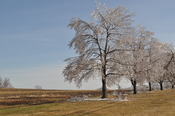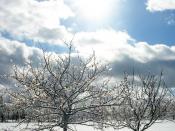Ice storms and severe winter storms (snowstorms) fall under the category of meteorological hazards as they are associated with atmospheric weather conditions. Ice storms involve freezing rain that result in an accumulation of ice greater than 0.25 inches. On the other hand, sever winter storms are cyclonic weather hazards that occur at cold temperatures and involve excess snow, sleet and ice. For a general classification of a severe winter storm, there must be an accumulation of at least 4 inches within 12 hours or 6 inches within a 24 hour period (Coppola, 2007). A good emergency management program for ice and severe snowstorms addresses all the phases of disaster management: mitigation, preparedness, response and recovery. An exploration of disaster management in the area of ice and winter storms is valuable as it is so common in Canada and the U.S. Thus, an examination of the various ways in which these phases are implemented for winter and ice storms, throughout localities and regions in North America, is crucial as it gives an idea of the phase(s) - mitigation, preparedness, response and recovery - that may have possible weaknesses, and would require improvements.
Ice storms include such negative consequences as breakage of tree limbs, falling of power lines, collapsing of roofs, and accidents on roads. Winter storms make travel quite difficult and dangerous and can lead to secondary hazards such as avalanches and floods. It is quite obvious that the likelihood of winter and ice storms is certain in Canada and parts of the U.S. In 2008, there were about 21 winter storm deaths in the US, and this number was up from last year of 16 (Office of Climate, Water and Weather Services, 2009). In March 1993, a severe snowstorm that affected US and Canada on the east coast killed over...


